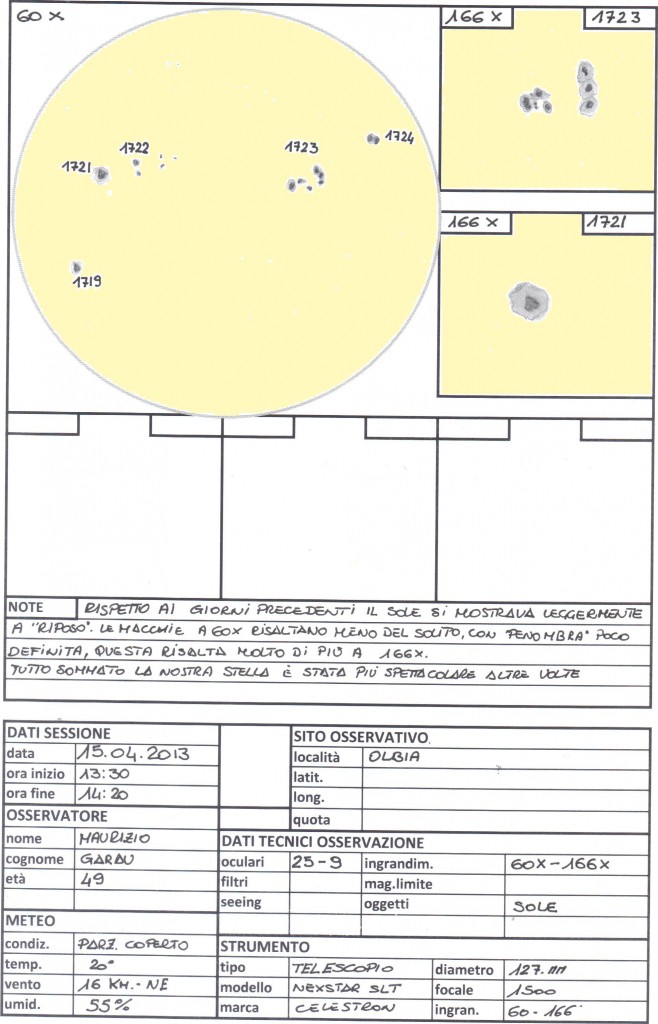
Object Name:Sun.
Object Type: Sunspots
Location: Olbia, Italy
Date: 04/14/2013
Media: graphite pencil ; Paint.
Telescope Celestron Mak 127/1500 with eyepieces 25/9 mm
Filter astrosolar.
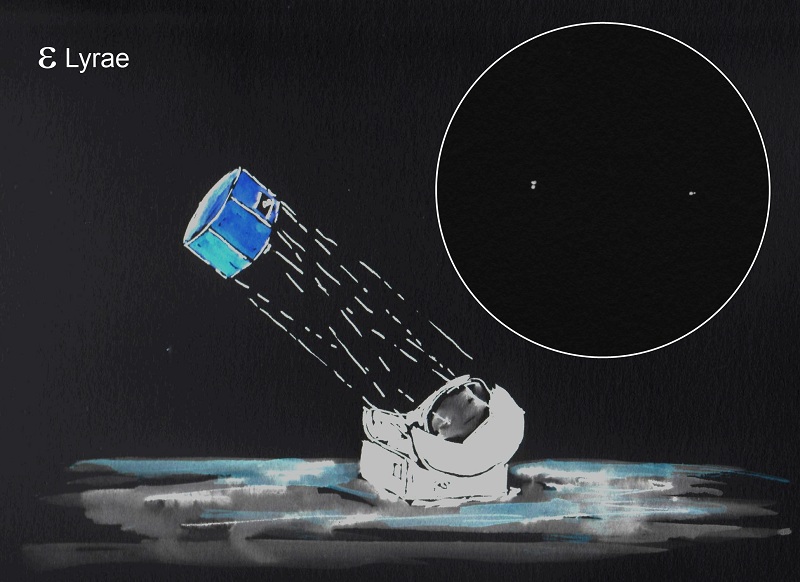
Hello astro-sketchers, here my last contribution…
Object Name (Epsilon1/2 Lyrae the Double double)
Object Type (Multiple Star)
Location (Château de Berne – Provence – France)
Date (May 8th)
Media (watercolor and ink, inverted while scanning)
Epsilon Lyrae, the “double-double” star, seen in the 450mm Dobson of my friend Philippe.
During this 4th yearly animation made in the “Château de Berne”, a nice vineyard domain in Provence, I had the opportunity to sketch this difficult multiple star.
The northern star is called ε1 and the southern one is called ε2; they both lie around 160 light years from Earth and orbit each other. In this big 450mm eye, both stars of the binary can be further split into binaries; that is, the system contains two binary stars orbiting each other. The component stars of ε1 have magnitudes of 4.7 and 6.2 separated by 2.6″ and have an orbital period that can only be crudely estimated at 1200 years, which places them at roughly 140 AU apart. The component stars of ε2 have magnitudes 5.1 and 5.5 separated by 2.3″, orbit perhaps half that period. ε1 and ε2 themselves are not closer than 0.16 light years apart, and would take hundreds of thousands of years to complete an orbit.
I made the watercolor taking into account the further inversion needed, that means black for white and orange for blue, for example.
Astro sketch website : http://astro.aquarellia.com
Clear sky to you all !
Michel Deconinck
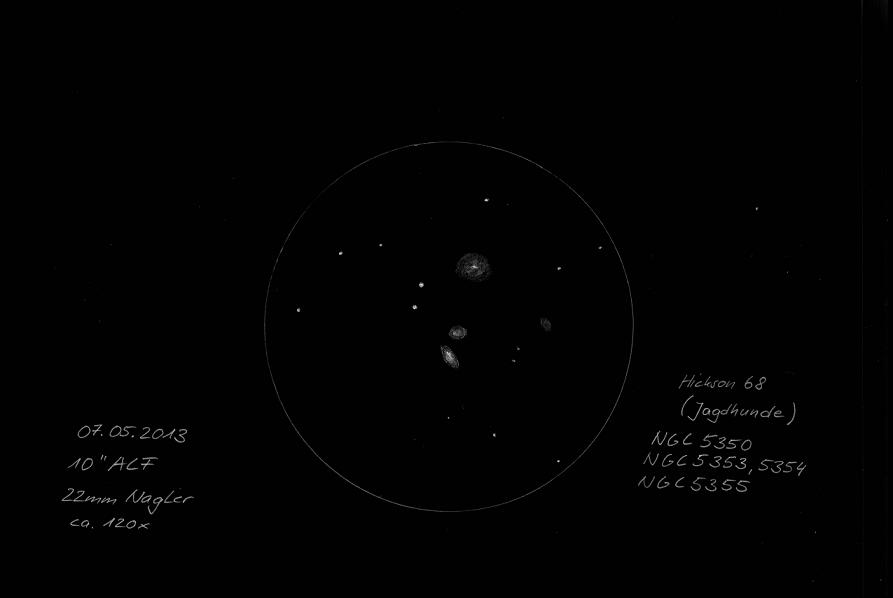
Hello,
on the night of 07th on the 08th May, I had good conditions: no wind, warm temperatures (about 14°C) and clear sky.
So I observed the area between Bootes and Ursa Major till midnight. After lot of nice galaxies I steered my telescope to Hickson 68.
The Galaxies around NGC 5350 in the vicinity of a pretty yellow and blue double star are a great few. Only the faintest galaxy NGC 5358 was imperceptible. After 20 minutes I had placed the stars and the galaxies NGC 5350, 5353, 5354, 5355 on my sketchpad.
It was one of the nights where I enjoy working with the Deep Sky observers Atlas by Gerhard Stropek. I traveled from galaxy to galaxy and simply enjoyed the light of the stars.
And so I hope that you like my sketch.
CS Uwe
Location: Germany near Tauberbischofsheim
Telescope: 10″ ACF on Vixen SXD
Eyepiece: 22mm Nagler
Sketch: pencil on white paper inverted colours
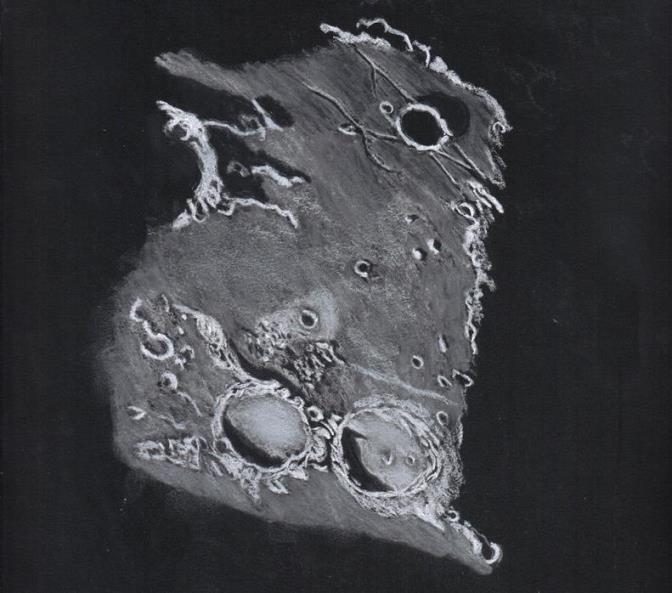
Craters Mercator, Campanus and Ramsden
Move cursor over image to view labels.
After another canceled public telescope viewing Friday evening due to thick clouds and light snow, I was pleased to see a nice Saturday filled with sunshine followed by a clear night.
With no particular sketching targets in mind, I scanned the terminator for interesting sketching targets and stopped when I could see sunrise at Ramsden (26 km.) along with all those crisscrossing rimae (rilles).
Northeastward away from Ramsden and across Palus Epidemiarum, I also added two additional ancient craters Mercator (49 km.) and Campanus (49 km.).
This break in our poor Chicagoland spring weather was long overdue.
Sketching:
For this sketch I used: 400 series black Strathmore Artagain paper 9″x 9″, white and black Conte’
pastel pencils , and Conte’crayons, a blending stump, plastic eraser.
Telescope: 10 inch f/5.7 Dobsonian with 6mm (241x)
Date: 4-21-2013 01:00 – 02:45 UT
Temperature: 7.2°C (45°F)
Weather: clear, calm
Seeing: good Antoniadi II-III
Co longitude: 35.4°
Lunation: 10.6 days
Illumination: 74.1%
Frank McCabe
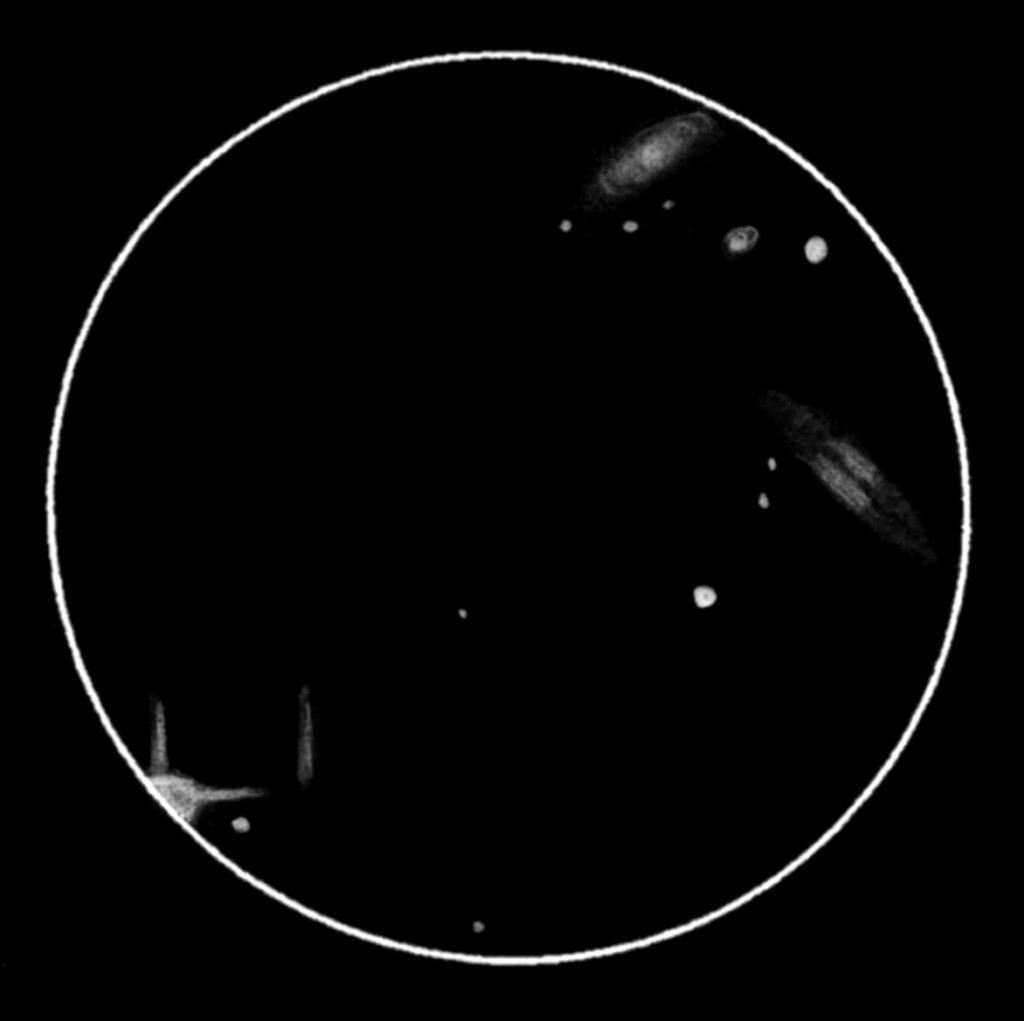
After a busy very garden weekend both at home and on the allotment, Saturday night out under the stars, a flying visit to Aldershot and back on Sunday and finishing the weekend off with a late night out at the Folk club, I was flagging when Monday evening offered a clear sky! But with the ongoing run of cloud wrap the UK has had, no opportunity should be missed for starlight! So just one sketch I told myself.
Ok so e start off with Arp 138 aka NGC 4015 located in Coma Berenices right onto the border with Leo, a very interesting galaxy with what I believe is a jet emanating from its western side and extending SW-NE. Other galaxies in the sketch are NGC 4021 top left, NGC 4011 to right, NGC 4023 bottom left. To be able to witness such massive forces in action far out across the universe is a privilege of very few people on earth and that is just how I feel, privileged.
OK with this Arp and neighbours safely to paper I scouted the local vicinity for anything else of interest whilst I was there, so much for just the one sketch! There were no shortage of galaxies very close, one group caught my eye and I moved the scope to encompass as many as I could in the small field of view what I got was fantastic group of diverse galaxies just into Leo and just to the west of Arp 138. In a clockwise direction from top right in my sketch below we have NGC 3993 at mag 11.83, showing nice spiral structure, next there is tiny NGC 3989 with a tiny hook like feature of detail observed, mag 14.9, to the west, an amazing edge on with stunning dust lane, NGC 3987 at mag 13.1. Last but not least to the SE next to a bright mag 8.2 star, is a faint, very thin, very straight edge on, N-S orientation, this is NGC 4000 a mag 14.5 absolute beauty 🙂
Right it’s time for bed, one more sketch in the bag than I had intended so not bad, but with the need to be up for work by 05.30am I closed up.
Do you want to know more about my interest in astronomy? If so take a look at my Website: http://www.chippingdaleobservatory.com/
Keep up to date with observations from Chippingdale Observatory by reading the Blog http://chippingdaleobservatory.com/blog/
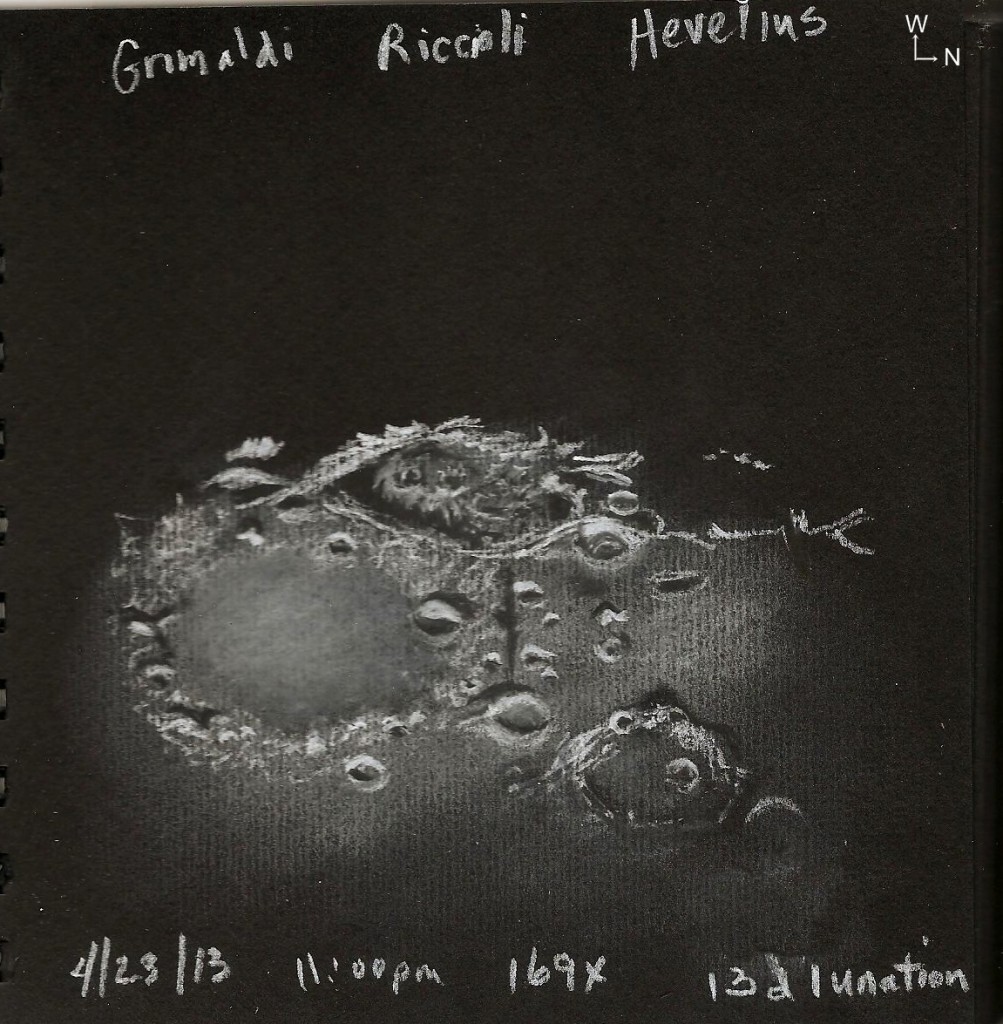
Riccioli and Grimaldi Craters
Move cursor over image to view labels.
Aloha!
After a bit of a slump, I decided to get out & observe a little of our Moon. On the lunar west limb I spotted 2 craters that appeared so different from one another that I was intrigued. I knew that one was Grimaldi but was not certain about the other. I sat down to sketch at the eyepiece on a night of good seeing conditions in Hawaii.
Riccioli Crater is the large (140 km) lunar impact crater at the western terminus of the sketch. It is bordered to the southeast by the larger (230 km) Grimaldi & to the northwest by Hevelius. Hedin is still in the darkness and only the edge becoming lit.
Riccioli appears elongate with rough crater walls casting sharp jagged shadows into the basin. There is also visible roughness & debris within the crater. This debris & other striated formations in the region are believed to have been created by ejecta from the formation of the Orientale impact basin to the southwest not seen here. The roughness of Riccioli is in stark contrast to Grimaldi which appears smooth by comparison. Grimaldi, covered in lava makes it appear more like a mare than a crater.
There appears to be a dark line or peak running from Riccioli to crater Lohrmann directly to the east. Multiple small brightly lit rimmed craters surround this area. A double crater with 2 bright rims of light can be seen at the northeast edge of Riccioli.
Both Riccioli & Grimaldi craters were named by 17th century Jesuit priests & colleagues Francesco Maria Grimaldi & Giovanni Baptista Riccioli, who were responsible for many of the names given to features on the Moon today.
Thia (Cindy) Krach
12.5” Portaball 169x
Maui, Hawaii
4/23/13
Black Fabriano paper
white & black charcoal pencils